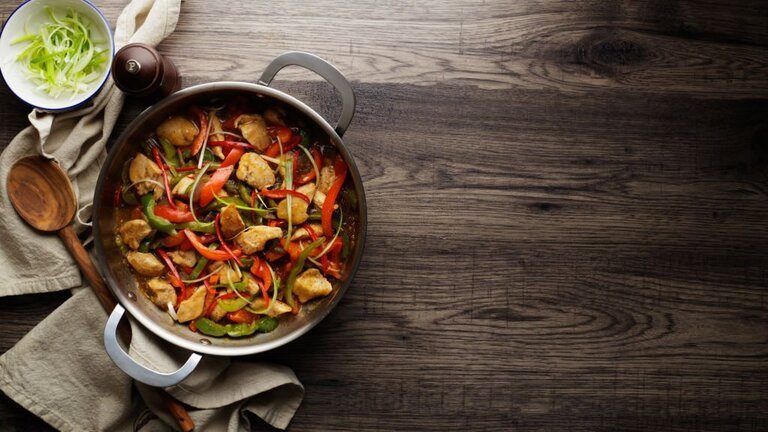One of your most crucial cooking utensils should be a decent skillet. If you want to acquire a pan that is truly ideal for home cooking, get a sauté pan! The information provided below will assist you in understanding what a saute pan is and how to choose a saute pan.
1. What Is a Saute Pan

The saute pan features a flat bottom, straight sides, a long handle, and a cover. Sometimes they have a short "helper" handle opposite the main one, as shown in this photo. When you use a saute pan to sauté something, every aspect is vital. That is why you should never allow anyone to sell you a frying pan or frying pan. Can you use these to cook chicken breasts or fish filets? Of course, but not as well as a typical, well-designed saute pan.
The idea behind stir-frying is to cook food fast at high heat with a small amount of fat (butter or oil). In advertisements or on culinary shows, chefs are frequently seen throwing pans back and forth over tremendous flames, occasionally flipping food through the air so they fall entirely in the pan.
2. How to Choose a Saute Pan
Handle

You need a long handle for several reasons. On top of the stove, you move the pan around a little. You may not be flipping items in the air, but you are shaking back and forth. You may also be shifting the pan from the stovetop to the oven to complete cooking. A long, robust handle has a fantastic feel to it when cooking, so choose pans that feel well in your hands.
Whatever you want to use your saute pan for, you'll need a sturdy pan with a handle that won't slip when you're holding it. So search for frying pans with firmly fastened handles. You want one with heavy-duty screws or studs for the handles.
Some modern cookware on the market has heat-resistant handles that assist avoid burns when used on the stove. This is useful for moving the pot from the burner to the sink, but be cautious if you put it inside for any reason.
Cool-proof does not imply water-proof. When removing any cookware from a hot oven, always use oven gloves, which means your pan handles should be oven safe. You may like the look of a wooden handle over a metal one, but you can't use it in the oven, so forget about it.
Material

There are several schools of thought on what a good pan should be built. You will learn about the many materials available, such as copper, aluminum, cast iron, stainless, nonstick, and a mix of materials. Each material has advantages and disadvantages, including price.
Because of the nature of sautéing, you want a pan that responds swiftly to heat and cools down just as quickly. This has to do with the conductivity of a pan. This refers to the pan's capacity to transfer heat from the heat source to the food in an even and effective manner. A well-made sauté pan is called highly conductive when it can transfer heat uniformly over the bottom and up the side, allowing the food to cook as it should. Because each metal conducts heat differently, it is critical to match the type of pan you are using with the method you cook.
Copper is the best conductivity material. The issue with copper is that it is expensive and difficult to maintain. I don't have time to clean my pots and pans, but it may be just me. Anodized aluminum pans, in my opinion, are the way to go. They carry heat well, are far less expensive than copper, and are easy to clean. Make certain that the pan is constructed of high gauge material and that the bottom is thick. A thin bottom is a problem waiting to happen since it typically transmits heat unevenly and develops hot spots.
All pans, like ovens, have hot zones. The cheaper pans just have more and larger hot spots. If you plan on doing a lot of cooking, you should invest in a few high-quality cookware. And who doesn't have to cook on a daily basis? If you want to save money on the pot you use to cook your corn and pasta, go ahead, but spend the extra money on the sauté pan.
Cooktop

Cooktop is also one of the factors on the list of how to choose a saute pan. When selecting the ideal saute pan, consider the stove top. Flat cooktops are ideally paired with pans that have thick, flat disc bases made of multi-ply metals. Furthermore, the thick disc bottoms evenly distribute heat and reduce hotspots, which is a benefit on any range. A flat bottom is also required to facilitate the swaying action of the burner.
When cooking with gas, the optimal pan option will have, in addition to a flat bottom, a "clad" structure of layered metals (from 2 to 7-ply) designed to distribute heat evenly across the whole pan.
Sporty and mid-size

A saute pan is not a substitute for a full-sized frying skillet. For starters, just the tossing action necessitates a medium-weight pan that can be readily handled and manipulated. Unwieldy is dangerous. A saute pan, on the other hand, must be broad enough (about 10 1/2 inches) to accommodate ingredients without crowding them. Too much food in the pan will lengthen the cooking time and cause the contents to steam or boil instead of sauté. If this pan were a car, it'd be a sports car with a backseat that everyone knows is purely for show.
Saute pans are measured in quarts and come in capacities ranging from 2 to 7 quarts. Experts believe that 3- to 5-quart pans are often chosen.
Lid

Lid plays an important role on the list of how to choose a saute pan. The most versatile saute pans have robust, snug-fitting lids that can be used both on the stovetop and in the oven. Although see-through tempered glass tops appear to be a nice idea, they frequently steam up during cooking, making them as opaque as a solid lid.
Choosing Sides
Traditionally, saute pans have relatively high, L-shaped edges that help to keep oil splatters to a minimum and prevent spilling if the recipe calls for transferring from burner to oven. The tall sides are particularly great for making sauces to go with sautéed vegetables.
Consider a deeper, splayed-edge pan or rounded bowl form with convenient pouring sides and a smaller bottom surface if you want things saucy. Finally, it is the recipes and culinary aspirations that determine the necessity.
Conclusion
In general, the criteria listed above are important to consider on how to choose a saute pan. These characteristics are also affected by how many servings you need to prepare on a daily basis, as well as how long and robust the handle should be. If you can discover a product that satisfies both of these criteria and is built of high-quality materials, you should buy it.













